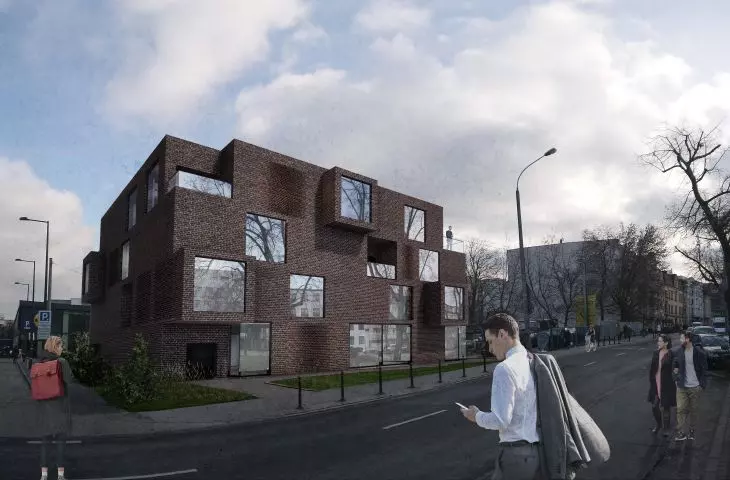{tag:studenci}, a student at the Architecture Department of Poznan University of Technology, received the Prize of the Minister of Development and Technology, in the category of engineering works in the 49th edition of the competition. Her diploma project is a proposal for a Koscielna 36 office building with a distinctive openwork brick facade, which could be built in Poznan's Jeżyce district.
The competition for the Prize of the Minister of Development and Technology for the best diploma theses (master's and engineering), doctoral dissertations and publications in the fields of architecture and construction, planning and zoning, and housing was held for the forty-ninth time. In this edition, a total of one hundred and eleven theses were submitted in four categories, and thirty-two were awarded.
The office building was designed on Koscielna Street in Poznan
© Michalina Linkowska
In the category of engineering projects, the jury selected six diplomas - among them was the work of Michalina Linkowska. The award-winning work entitled Design of an office building on Koscielna Street in Poznan was carried out at the Institute of Architecture, Urban Planning and Heritage Protection, in the Department of History, Theory and Protection of Heritage under the direction of Dr. Agnieszka Rumiez.
While conducting the analysis, the author also created sketches
© Michalina Linkowska
Koscielna street and Jezyce district
Michalina Linkowska's engineering work was preceded by a thorough analysis of the project plot and the Jeżyce district.
The office building I designed is located at 36 Koscielna Street in Poznan. The Jeżyce district, which includes this plot, is a very important area for the city. Meandering Koscielna Street is a district-forming place, its shape has remained unchanged since the days when Jeżyce was still an oval village. Along Koscielna Street, compact, frontage buildings, characteristic of downtown areas, dominate, forming distinct urban walls along both roadways. The study plot represents a clear break in the continuity of frontage, significant in the perception of the site. The curvilinear roadways of Church Street divide the space, which is sharply cut off from the north by the railroad embankment, which forms a significant negative boundary band, and from the south by the narrowing at the intersection of Church Street and Narrow Street. This strongly separated scenic area lacks a strong element that would provide a reference point and reflect the identity of the place. A park with a water reservoir is to be built between the two roadways of Church Street in the future. A thriving district needs places that move with the times, while at the same time respectfully referring to the existing buildings, says the project's author.
design road scheme
© Michalina Linkowska
an office building for today's times
The student, in order to realize the assumptions she set for herself (identity of the place, modernity), proposed a body of the building carved with a series of bay windows and niches, with a facade made of demolition bricks.
Koscielna 36 is an office building not only for Jeżyce, but also for today's times. A responsible approach to environmental impact, both during construction and during operation, is a response to the climate crisis, Michalina adds.
A characteristic element is the use of demolition bricks
© Michalina Linkowska
brick openwork
In order to reduce the carbon footprint, the author applied solar architecture solutions, taking advantage of the above-average sun exposure for a downtown. In addition, she designed an atrium, providing light to the office space, and a brick openwork, creating a game of chiaroscuro in the interiors and completing the composition of the block.
The brick openwork lets light into the building's interiors
© Michalina Linkowska
The designer used brick openwork on the facade in such a way that it subtly lets sunlight into the interiors. She planned the transition from the face of the wall to the turned bricks gradually, so that it changes smoothly and introduces a curvilinear element, breaking the orthogonal composition of the solid. The layout was designed with Grasshopper, using parametric design elements.
The building consists of four levels and an underground garage
© Michalina Linkowska
acoustic booths
The student used a number of modern and user-friendly amenities in the office section. She proposed telephone acoustic booths as a solution to the noise problem.
The acoustic booths can be used both standing and sitting
© Michalina Linkowska
When an employee of a multi-person workstation needs to make a phone call or participate in a video conference, he or she has the option of using the individual space without worrying about disturbing co-workers in the process. The ability to adjust the height of the tabletop and seat promotes the use of the booth both sitting and standing. This gives you a chance to change your working position, which has a positive effect on a person's musculoskeletal system, and thus his or her health and well-being," explains Michalina.
The space of the office building also includes places to relax amidst greenery
© Michalina Linkowska
thoughtful decisions
The architect designed the office building with the IT industry in mind, but, out of concern for the building's durability, the functional layout allows easy adaptation to other functions. She equipped the office space with group work stations, and arranged recreation and relaxation areas in the bay windows. In addition to acoustic booths, she introduced abundant greenery into the interiors.
I tried to make every decision - artistic, functional, related to installations or plant species - with special care for the environment, both working and natural," the author concludes.






















































